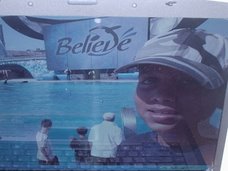Last year news broke out that the US water supply was contaminated with pharmaceutical.The source of the problem might be the big pharm's, but the more immediate culprit was hard to determine - it was your neighbor, you kids teacher, maybe even you. We had contaminated our own water system simply by over medicating ourselves. Our own waste was literally polluting those of who were using the meds and the rest of us who might be med free. A couple of weeks later we all forgot about it, after repeatedly being reassured that the amounts in our water system were so small that they posed "absolutely no danger." Who knows if we were right or wrong to simply let that pass as another unfortunate and supposedly benign consequence of modern life. Now another story about medicated water systems is hitting the news - this one internationally, and perhaps of even more dire consequence.It seems researchers have recently analyzed waste water in Patancheru, India and were shocked to find enough of a single ant-biotic (Ciproflaxin) being spewed into one stream each day, to treat a city of 90,000 residents. But it wasn't just the anti-biotic, it was a medicine cabinet full of meds floating through the supposedly cleaned water - a cocktail of 21 different active pharmaceutical ingredients. Medication treating everything from hypertension, heart disease, chronic liver ailments, depression, gonorrhea, ulcers and other ailments.
The story on the U.S contamination last year was found in drinking water that was provided for 40+ million people, but the water tested in India contained 150 times the highest level in the U.S. In fact, half of the drugs measured at the highest levels of pharmaceuticals ever detected in the environment, researchers said."If you take a bath there, then you have all the antibiotics you need for treatment," said chemist Klaus Kuemmerer at the University of Freiburg Medical Center in Germany, an expert on drug resistance in the environment who did not participate in the research. "If you just swallow a few gasps of water, you're treated for everything. The question is for how long?"Researchers have found that human cells fail to grow normally in the laboratory when exposed to trace concentrations of certain pharmaceuticals. Some waterborne drugs also promote antibiotic-resistant germs, especially when - as in India - they are mixed with bacteria in human sewage. Even extremely diluted concentrations of drug residues harm the reproductive systems of fish, frogs and other aquatic species in the wild. Other research found tadpoles exposed to water from the treatment plant that had been diluted 500 times were nonetheless 40 percent smaller than those growing in clean water. The discovery of this contamination raises two key issues for researchers and policy makers: the amount of pollution and its source. Experts say one of the biggest concerns for humans is whether the discharge from the waste water treatment facility is spawning drug resistance."Not only is there the danger of antibiotic-resistant bacteria evolving; the entire biological food web could be affected," said Stan Cox, senior scientist at the Land Institute, a nonprofit agriculture research center in Salina, Kan. Cox has studied and written about pharmaceutical pollution in Patancheru. "If Cipro is so widespread, it is likely that other drugs are out in the environment and getting into people's bodies."So who is to blame you might wonder? The approximately 90 factories that manufacture generic drugs for most of the world in the area. Patancheru became a hub for largely unregulated chemical and drug factories in the 1980s, creating what one local newspaper has termed an "ecological sacrifice zone" with its waste. Since then, India has become one of the world's leading exporters of pharmaceuticals, and the U.S. - which spent $1.4 billion on Indian-made drugs in 2007 - is its largest customer.
A spokesman for the Pharmaceutical Research and Manufacturers of America, representing major U.S. drug makers, said they could not comment about the Indian pollution because the Patancheru plants are making generic drugs and their members are branded. A spokesman for the Generic Pharmaceutical Association said the issues of Indian factory pollution are "not within the scope of the activities" of their group.Drug factories in the U.S. and Europe have strictly enforced waste treatment processes. At the Patancheru water treatment plant, the process is outdated, with wastewater from the 90 bulk drug makers trucked to the plant and poured into a cistern. Solids are filtered out, then raw sewage is added to biologically break down the chemicals. The waste water, which has been clarified but is still contaminated, is dumped into the Isakavagu stream that runs into the Nakkavagu and Manjira, and eventually into the Godawari River. The victims are amongst the poorest villagers in India in the surrounding areas."I'm frustrated. We have told them so many times about this problem, but nobody does anything," said Syed Bashir Ahmed, 80, casting a makeshift fishing pole while crouched in tall grass along the river bank near the bulk drug factories. "The poor are helpless. What can we do?
(Source: Associated Press)
Joy. Jodhpur. Rajasthan
12 years ago





No comments:
Post a Comment